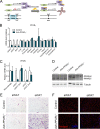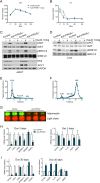Peroxisome Proliferator-Activated Receptor γ and Its Role in Adipocyte Homeostasis and Thiazolidinedione-Mediated Insulin Sensitization
- PMID: 29483301
- PMCID: PMC5954194
- DOI: 10.1128/MCB.00677-17
Peroxisome Proliferator-Activated Receptor γ and Its Role in Adipocyte Homeostasis and Thiazolidinedione-Mediated Insulin Sensitization
Abstract
Adipose tissue is a dynamic organ that makes critical contributions to whole-body metabolic homeostasis. Although recent studies have revealed that different fat depots have distinct molecular signatures, metabolic functions and adipogenic mechanisms, peroxisome proliferator-activated receptor γ (PPARγ) is still widely viewed as the master regulator of adipogenesis and critical for maintaining mature adipocyte function. Using an inducible, adipocyte-specific knockout system, we explored the role of PPARγ in mature adipocytes in vivo Short-term PPARγ deficiency in adipocytes reduces whole-body insulin sensitivity, but adipocytes are viable both in vitro and in vivo However, after exposure to a high-fat diet, even short-term PPARγ deficiency leads to rapid adipocyte death. When mature adipocytes are depleted of both PPARγ and CCAAT-enhancer-binding protein α (C/EBPα), they are rapidly depleted of lipids and undergo adipocyte death, both in vitro and in vivo Surprisingly, although thiazolidinediones (TZDs; PPARγ agonists) are thought to act mainly on PPARγ, PPARγ in adipocytes is not required for the whole-body insulin-sensitizing effect of TZDs. This offers new mechanistic aspects of PPARγ/TZD action and its effect on whole-body metabolic homeostasis.
Keywords: C/EBPα; PPARγ; adipocyte; adipose tissue; inducible knockout; insulin sensitization; mouse model; obesity; thiazolidinedione.
Copyright © 2018 American Society for Microbiology.
Figures







Similar articles
-
Adipocyte-specific expression of murine resistin is mediated by synergism between peroxisome proliferator-activated receptor gamma and CCAAT/enhancer-binding proteins.J Biol Chem. 2009 Mar 6;284(10):6116-25. doi: 10.1074/jbc.M808407200. Epub 2009 Jan 5. J Biol Chem. 2009. PMID: 19126543 Free PMC article.
-
Impact of increased PPARgamma activity in adipocytes in vivo on adiposity, insulin sensitivity and the effects of rosiglitazone treatment.Endocr J. 2008 Aug;55(4):767-76. doi: 10.1507/endocrj.k08e-018. Epub 2008 May 28. Endocr J. 2008. PMID: 18506083
-
PPARgamma regulates adipose triglyceride lipase in adipocytes in vitro and in vivo.Am J Physiol Endocrinol Metab. 2007 Dec;293(6):E1736-45. doi: 10.1152/ajpendo.00122.2007. Epub 2007 Sep 11. Am J Physiol Endocrinol Metab. 2007. PMID: 17848638 Free PMC article.
-
Role of PPARg2 transcription factor in thiazolidinedione-induced insulin sensitization.J Pharm Pharmacol. 2012 Feb;64(2):161-71. doi: 10.1111/j.2042-7158.2011.01366.x. Epub 2011 Oct 13. J Pharm Pharmacol. 2012. PMID: 22221092 Review.
-
Peroxisome proliferator-activated receptor gamma and the regulation of adipocyte function: lessons from human genetic studies.Best Pract Res Clin Endocrinol Metab. 2005 Dec;19(4):501-23. doi: 10.1016/j.beem.2005.10.001. Best Pract Res Clin Endocrinol Metab. 2005. PMID: 16311214 Review.
Cited by
-
Endoplasmic Reticulum Stress and Its Impact on Adipogenesis: Molecular Mechanisms Implicated.Nutrients. 2023 Dec 12;15(24):5082. doi: 10.3390/nu15245082. Nutrients. 2023. PMID: 38140341 Free PMC article. Review.
-
TGF-β is insufficient to induce adipocyte state loss without concurrent PPARγ downregulation.Sci Rep. 2020 Aug 21;10(1):14084. doi: 10.1038/s41598-020-71100-z. Sci Rep. 2020. PMID: 32826933 Free PMC article.
-
A comparative assessment of reference genes in mouse brown adipocyte differentiation and thermogenesis in vitro.Adipocyte. 2024 Dec;13(1):2330355. doi: 10.1080/21623945.2024.2330355. Epub 2024 Mar 25. Adipocyte. 2024. PMID: 38527945 Free PMC article.
-
Perivascular adipose tissue dysfunction contributes to thoracic aortic aneurysm development.Cardiovasc Diabetol. 2025 May 21;24(1):223. doi: 10.1186/s12933-025-02765-x. Cardiovasc Diabetol. 2025. PMID: 40399937 Free PMC article.
-
The Role of Persistent Organic Pollutants in Obesity: A Review of Laboratory and Epidemiological Studies.Toxics. 2022 Feb 2;10(2):65. doi: 10.3390/toxics10020065. Toxics. 2022. PMID: 35202251 Free PMC article. Review.
References
Publication types
MeSH terms
Substances
Grants and funding
LinkOut - more resources
Full Text Sources
Other Literature Sources
Molecular Biology Databases
